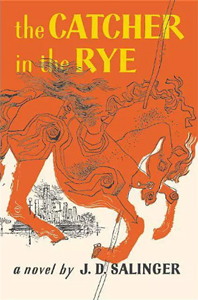In one of “The Catcher in the Rye’s” (1951) New York City walkabout vignettes, narrator Holden Caulfield attempts to strike up an intellectual conversation with Carl Luce. His old classmate isn’t in the mood, preferring to sit quietly at the bar and drink.
It’s still true today, in fact probably more so: Intellectual conversation about art and culture is not a widely enjoyed pastime. If it was, J.D. Salinger’s classic novel might be a popular topic of such discussions. It’d be hard to give it a controversial rating, though.
It makes sense to love the novel, as it is a crisply written, easy-to-read slice-of-life about a supremely disaffected teen. It also makes sense to hate the novel, as Holden is (purposefully by Salinger) annoying. Almost every normie he interacts with finds him irksome. Maybe it’s unfair to use a reader’s feeling for the book as a measure of their empathy, but certainly Salinger invites us to engage with Holden and react to him.

“The Catcher in the Rye” (1951)
Author: J.D. Salinger
Genre: Character drama
Setting: New York City, 1951
Perhaps the most fascinating thing about “Catcher” is that it’s a classic despite lacking a dramatic plot, on-the-nose themes or an impactful ending. (Also fascinating: It used to be a regular on Banned Book lists, but it’s also a staple in high school curriculums – but this overlap isn’t as uncommon as you’d think. Both statuses ultimately measure a book’s fame.) Here’s an interesting thought experiment: What would I think of the novel if it wasn’t famous – if it was instead a little-known work by a little-known author?
I believe I’d enjoy it, but its classic status makes me want to find other folks’ analyses of it, in part simply because I know they are out there. If this was a little-known work, I’d have to figure out the symbolism of Holden’s ear-flapped hunting hat on my own, or with book club mates on the off chance this oddball book got selected.
Holden’s hard life
Actually, here’s a controversial statement. In the Fifties, Philip K. Dick wrote his nine realist novels (none were published at the time, unfortunately) and I like most of them better than “Catcher.” They all feature artistic and intellectually minded young people alienated by the culture around them. Because of the messier writing style and more melodramatic plots, PKD’s West Coast novels land harder for me, and stick with me more than Salinger’s vastly more lauded East Coast catalog.
“Catcher” has a notably soft landing. Really, it’s about a teen with mental health issues — or, alternatively, a relatable teen with a sensible view of a world packed with people with mental health issues. Let’s just say he’s an outsider.

The plot, such as it is, is that Holden – having been kicked out of his boarding school before Christmas break for his low grades – plans to do something drastic, perhaps moving out west to work on a ranch. We’re also invited to think he might kill himself, as everything depresses the hell out of him, even an ancient teacher’s inability to toss a magazine onto a bed. When he picks a fight with his large roommate, it’s the very definition of “asking for it.” But it turns out he doesn’t do anything more dramatic than get plastered and wake up everyone he knows in the middle of the night to chat.
As in all of Salinger’s work, the POV character exists in relatable conditions and holds relatable conversations, but little things give his writing extra punch. With Holden, it’s how he talks in the slang and parlance of 1951.
Holden starts this 214-page account with “If you really want to hear about it …,” and because his narration is so folksy, I do. He leads into events with “So what I did was …” and closes with “I wish you could’ve seen it.” He exaggerates everything – “millions” of people invade a bus station at dawn, a school secretary is “100 years old,” and everyone behaves “like madmen.” So do inanimate objects, like metal hangers when you’re attempting to hang up your jacket.
Modestly underwritten
Aside from Holden’s verbal ticks, I feel like Salinger underwrites (as in, the opposite of overwrites) on purpose, like he doesn’t want to show off. I remember this effect being even more pronounced in his Glass family stories, found in the dual-novella collections “Franny and Zooey” and “Raise High the Roof Beam, Carpenters, and Seymour: An Introduction,” and many short stories.
Interestingly, showing off ends up being a theme of the book, and it’s fun to compare that with Salinger’s life and career choices. Despite Holden’s dislike of almost everyone except kid sister Phoebe and deceased brother Allie, he actually does respect some former teachers, and gets advice from Mr. Antolini in what passes for the climax of the novel. Providing the requisite depressing overlay, Antolini might possibly be putting drunken moves on Holden, although it’s ambiguous.
Before Holden’s awkward departure, Antolini says he fears the psychologically and spiritually troubled Holden might die nobly for a cause, rather than living humbly for one. Indeed, Holden has visions of being a “catcher in the rye” – someone who stops innocent kids from falling off a cliff when they burst forth from playing in fields of tall grain. Thus we have the book’s core conflict/theme, and it could eventually be applied to Salinger himself.
Famously, the author hated the publishing industry and (like Holden) the movie industry, which is why there are no adaptations of his work, no lavish printings of his four books, and no collections of his magazine short stories aside from those in “Nine Stories.” He stopped publishing after 1965, and withdrew from fame. Many experts believe he kept writing until his death in 2010 because he loved it, and that the public will never see those writings.
So we have no clear plot, no blatant theme, and – although it’s not wrong to label him “prolific” – technically “The Catcher in the Rye” is the only novel Salinger ever wrote. It does have quite a character, though.

